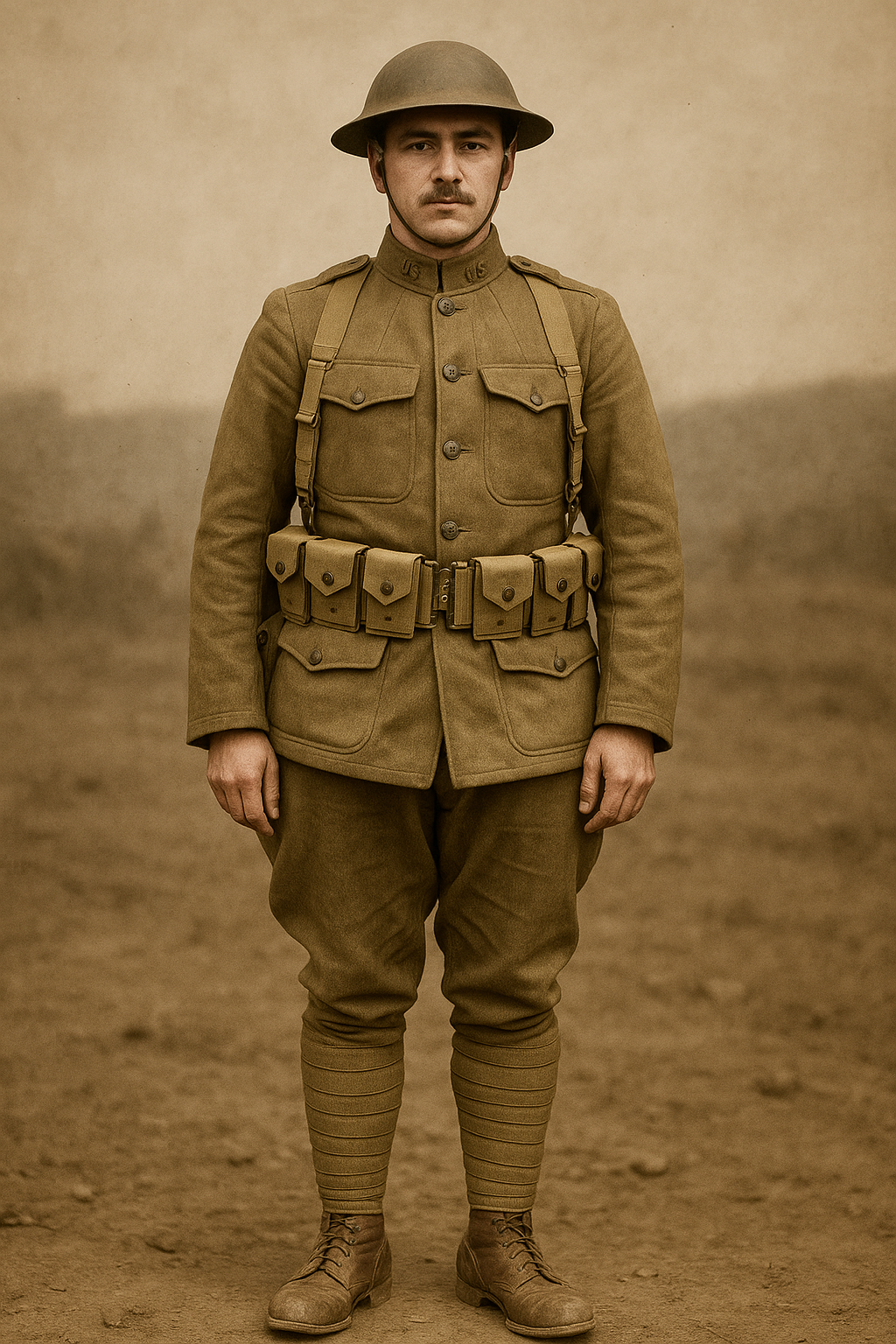
The Evolution of American Uniforms in WW1: A Complete Guide to US Army WW1 Soldier Gear
Published on Jul 23, 2025
The History and Design of WW1 Soldiers Uniforms: A Look into American Military Style
The First World War marked a turning point not only in global politics and warfare but also in military fashion. For the United States, entering the conflict in 1917 meant quickly adapting and innovating both tactics and uniforms. The WW1 soldiers uniform worn by American troops—commonly referred to as “Doughboys”—was a combination of practicality, durability, and identity.
In this article, we explore the US Army uniform WW1 style in depth. From headgear to boots, we’ll examine each element of the American uniforms WW1 and guide you to where you can find accurate historical reproductions.
Why WW1 Uniforms Were So Iconic
During World War I, uniforms served more than just practical needs—they also represented nationhood, hierarchy, and camaraderie. The U.S. military had to rapidly standardize its gear as it mobilized for war, and the result was a look that became iconic on the battlefield and in historical memory.
Key Components of the US Army Uniform in WW1
1. Headgear: The Doughboy Helmet (M1917)
Introduced to replace soft campaign hats, the British-style Brodie helmet—known as the M1917 helmet in American service—offered essential shrapnel protection. Its deep, bowl-shaped design is still closely associated with WW1 imagery.
2. Tunic: The M1917 Wool Service Coat
The standard US Army wool tunic featured four pockets, a standing collar, and a rugged construction suitable for trench warfare. Officers’ versions often included additional tailoring and insignia.
3. Trousers and Puttees
Wool breeches with tight cuffs were worn with puttees, long cloth strips wound around the lower legs for protection and support. These offered a rudimentary form of gaiter protection from mud and debris in trench environments.
4. Footwear
Initially, the US Army issued hobnail trench boots, which were gradually replaced with more durable models to support the long treks across Europe.
5. Insignia and Ranks
Unit patches, divisional insignia, and rank chevrons helped distinguish soldiers. For a full breakdown of symbols and their meanings, explore our detailed guide:
👉 WWI US Military Insignia Explained: Army, Navy, and USMC Rank Badges
The American Expeditionary Forces (AEF) and Uniform Variations
The American Expeditionary Forces (AEF) operated under General John J. Pershing and included over two million soldiers. The uniforms they wore reflected a blend of American and Allied influences. While primarily standardized, variations existed based on:
- Branch of service (Infantry, Artillery, Engineers)
- Rank and role (Enlisted vs. Officer)
- Location and supply chain availability
For example, aviators had custom leather jackets, and tank crews often wore British-style uniforms due to supply issues.
Fabric and Construction: Why Wool Dominated
Wool was the fabric of choice for most military uniforms during WW1 due to its insulation properties and durability. Despite being hot in summer, it remained warm even when wet—a vital feature in the cold, muddy trenches of Europe.
However, wool was scratchy and often poorly sized, leading to discomfort and widespread complaints among troops. Uniform improvements came slowly as feedback trickled from the front lines.
American Uniforms vs. Allied Counterparts
While French and British uniforms evolved over the war’s duration, the US Army adapted many of their features. For example, the US Army uniform WW1 shared the British helmet style and the French approach to unit insignia.
You can read more about uniform comparisons in our article:
👉 A Complete Guide to World War 1 Uniforms: From US Doughboys to French Infantrymen
Collecting and Reenacting with Authentic WW1 Uniforms
WW1 enthusiasts and reenactors seek historical accuracy when portraying American soldiers. Whether you're building a museum-grade display or preparing for a living history event, it's vital to use well-researched replicas.
At Paddelaters, we offer high-quality WW1 US AEF uniforms and gear with attention to authentic detail.
👉 Browse our collection here: WW1 US AEF Uniforms and Gear
Why the WW1 Uniform Still Matters Today
The WW1 American uniform symbolizes a time when the U.S. emerged as a global military power. These garments are not just relics—they're storytelling tools. They reflect the hardships of trench warfare, the brotherhood among soldiers, and the early steps of modern U.S. military identity.
Final Thoughts: Honoring the Doughboys Through Uniforms
Whether you're fascinated by military history or you're a reenactor striving for authenticity, understanding the WW1 soldiers uniform is essential. The US Army uniform WW1 was more than just fabric—it was part of a soldier’s identity. Today, thanks to dedicated historians and craftsmen, you can honor that legacy through accurate representations and detailed research.
By studying and wearing these American uniforms WW1, we preserve the memory of those who served and ensure their stories remain alive for generations.
FAQs
Q1: What was the main uniform worn by US soldiers in WW1?
A: The primary uniform was the M1917 wool service coat paired with breeches, puttees, and the M1917 steel helmet.
Q2: Where can I buy authentic WW1 uniform replicas?
A: You can find high-quality reproductions of WW1 US AEF uniforms and gear at Paddelaters.
Q3: What does “Doughboy” mean?
A: "Doughboy" was a nickname for American infantrymen in WW1, likely originating from the dusty appearance of soldiers marching through Mexico in earlier conflicts.
